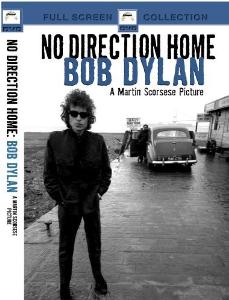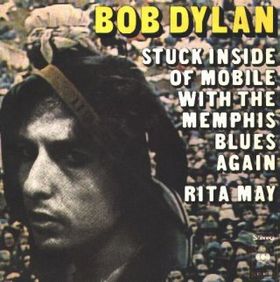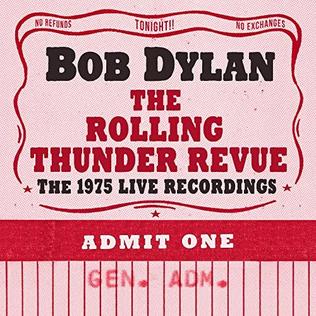Related Research Articles

Highway 61 Revisited is the sixth studio album by American singer-songwriter Bob Dylan, released on August 30, 1965, by Columbia Records. Having until then recorded mostly acoustic music, Dylan used rock musicians as his backing band on every track of the album, except for the closing track, the 11-minute ballad "Desolation Row". Critics have focused on the innovative way Dylan combined driving, blues-based music with the subtlety of poetry to create songs that captured the political and cultural chaos of contemporary America. Author Michael Gray has argued that, in an important sense, the 1960s "started" with this album.
"Desolation Row" is a 1965 song by the American singer-songwriter Bob Dylan. It was recorded on August 4, 1965, and released as the closing track of Dylan's sixth studio album, Highway 61 Revisited. It has been noted for its length (11:21) and surreal lyrics in which Dylan weaves characters into a series of vignettes that suggest entropy and urban chaos.

"Like a Rolling Stone" is a song by American singer-songwriter Bob Dylan, released on July 20, 1965, by Columbia Records. Its confrontational lyrics originated in an extended piece of verse Dylan wrote in June 1965, when he returned exhausted from a grueling tour of England. Dylan distilled this draft into four verses and a chorus. "Like a Rolling Stone" was recorded a few weeks later as part of the sessions for the forthcoming album Highway 61 Revisited.
"Visions of Johanna" is a song written and performed by Bob Dylan on his 1966 album Blonde on Blonde. Several critics have acclaimed "Visions of Johanna" as one of Dylan's highest achievements in writing, praising the allusiveness and subtlety of the language. Rolling Stone included "Visions of Johanna" on their list of the 500 Greatest Songs of All Time. In 1999, Sir Andrew Motion, Poet Laureate of the United Kingdom, listed it as the greatest song lyric ever written.

The Bootleg Series Vol. 5: Bob Dylan Live 1975, The Rolling Thunder Revue is a live album by Bob Dylan released by Columbia Records in 2002. The third installment in the ongoing Bob Dylan Bootleg Series on Legacy Records, it documents the Rolling Thunder Revue led by Dylan prior to the release of the album Desire. Until the release of this album, the only official live documentation of the Rolling Thunder Revue was Hard Rain, recorded during the second leg of the tour.

No Direction Home: Bob Dylan is a 2005 documentary film by Martin Scorsese that traces the life of Bob Dylan, and his impact on 20th-century American popular music and culture. The film focuses on the period between Dylan's arrival in New York in January 1961 and his "retirement" from touring following his motorcycle accident in July 1966. This period encapsulates Dylan's rise to fame as a folk singer and songwriter where he became the center of a cultural and musical upheaval, and continues through the electric controversy surrounding his move to a rock style of music.
"Ballad of a Thin Man" is a song written and recorded by Bob Dylan, and released in 1965 on his sixth album, Highway 61 Revisited.

"Just Like Tom Thumb's Blues" is a song written and performed by Bob Dylan. It was originally recorded on August 2, 1965, and released on the album Highway 61 Revisited. The song was later released on the compilation album Bob Dylan's Greatest Hits Vol. II and as two separate live versions recorded at concerts in 1966: the first of which appeared on the B-side of Dylan's "I Want You" single, with the second being released on The Bootleg Series Vol. 4: Bob Dylan Live 1966, The "Royal Albert Hall" Concert. The song has been covered by many artists, including Gordon Lightfoot, Nina Simone, Barry McGuire, Judy Collins, Frankie Miller, Linda Ronstadt, the Grateful Dead, Neil Young, The Black Crowes, Townes Van Zandt, and Bryan Ferry. Lightfoot's version was recorded only weeks after Dylan's original had been released and reached #3 on the Canadian RPM singles chart.

"Stuck Inside of Mobile with the Memphis Blues Again" is a song written by Bob Dylan that appears on his 1966 album Blonde on Blonde. The album version also appears on 1971's Bob Dylan's Greatest Hits Vol. II. An early studio take, done in a faster tempo, was released on The Bootleg Series Vol. 7: No Direction Home: The Soundtrack in 2005. As the recording indicates, Dylan had difficulty fitting the words to the tempo, and evidently this led to its rearrangement, as heard on Blonde on Blonde, in a more "rock"-oriented 4/4 time.

"Just Like a Woman" is a song written by Bob Dylan and first released on his 1966 album, Blonde on Blonde. It was also released as a single in the U.S. during August 1966 and peaked at #33 on the Billboard Hot 100. Dylan's recording of "Just Like a Woman" was not issued as a single in the United Kingdom but the British beat group, Manfred Mann, did release a hit single version of the song in July 1966, which peaked at #10 on the UK Singles Chart. In 2011, Rolling Stone magazine ranked Dylan's version of the song at #232 in their list of the 500 Greatest Songs of All Time.

"Can You Please Crawl Out Your Window?" is a folk rock song written by American musician Bob Dylan. In 1965, Columbia Records released it as a single, which reached number 58 on the US Billboard Hot 100 chart and number 17 on the UK chart in January 1966.
"One Too Many Mornings" is a song by Bob Dylan, released on his third studio album The Times They Are a-Changin' in 1964. The chords and vocal melody are in some places very similar to the song "The Times They Are A-Changin'". "One Too Many Mornings" is in the key of C Major and is fingerpicked.
"I'll Keep It with Mine" is a song written by Bob Dylan in 1964, first released by folk singer Judy Collins as a single in 1965. Dylan attempted to record the song for his 1966 album Blonde on Blonde.

"Rita May" is a song by Bob Dylan, originally recorded during the sessions for the album Desire, but released only as the B-side of a single and on the compilation album, Masterpieces. The song is based on the 1957 rockabilly song "Bertha Lou". Some listeners believe that the lyrics of the song refer to writer Rita Mae Brown, who had complained of the lack of opportunities for casual lesbian sex.

From Newport to the Ancient Empty Street in L.A is a bootleg recording of live performances by Bob Dylan. It contains recordings of Dylan performing at the Newport Folk Festival in July 1964 and July 1965. There are also recordings of Dylan performing at the Hollywood Bowl in September 1965. The album contains one performance omitted from the film The Other Side of the Mirror which records Dylan's Newport performances: a live version of "It Takes a Lot to Laugh, It Takes a Train to Cry" from July 1965.
"Mama, You Been on My Mind" is a song by American singer-songwriter Bob Dylan. Written in 1964 during a trip to Europe, the song dealt with his recent breakup with his girlfriend, Suze Rotolo. Dylan first recorded the song in June of that year during a session for his album Another Side of Bob Dylan. However, the song was not included on the album, and Dylan's version remained unreleased until 1991. In total, in the 1990s and 2000s four versions were put out on Dylan's Bootleg Series of releases, including two live performances with Joan Baez from 1964 and 1975.
Bob Dylan is an American musician, singer-songwriter, music producer, artist, and writer. He has been an influential figure in popular music and culture for more than five decades. Much of his most celebrated work dates from the 1960s when he was an informal chronicler and a seemingly reluctant figurehead of social unrest.

The Bootleg Series Vol. 12: The Cutting Edge 1965–1966 is a compilation album by American singer-songwriter Bob Dylan, released on Legacy Records in November 2015. The tenth installment in the ongoing Bob Dylan Bootleg Series, it comprises recordings from 1965 and 1966, mostly unreleased demos and outtakes from recording sessions for his ground-breaking albums Bringing It All Back Home, Highway 61 Revisited and Blonde on Blonde. The standard set peaked at #41 on the Billboard 200.
The Never Ending Tour is the popular name for Bob Dylan's endless touring schedule since June 7, 1988.

Bob Dylan – The Rolling Thunder Revue: The 1975 Live Recordings is a box set of 1975 live recordings by Bob Dylan, released on June 7, 2019. For this tour, Dylan assembled a loose collective of a backing band called Guam and played across North America for several dozen shows. The tie-in Netflix documentary film Rolling Thunder Revue: A Bob Dylan Story by Martin Scorsese was released the following week. A similar compilation was released in 2002 entitled Bob Dylan Live 1975, The Rolling Thunder Revue, as part of Dylan's ongoing Bootleg Series. That compilation was re-released on vinyl as a companion to the later release.
References
- ↑ Bruce Pollock (2014-03-18). Rock Song Index: The 7500 Most Important Songs for the Rock and Roll Era. Routledge. p. 188. ISBN 978-1-135-46296-3.
- 1 2 3 4 5 6 7 "It Takes a Lot to Laugh, It Takes a Train to Cry" . Retrieved 2009-06-24.
- 1 2 3 Hinchey, J. (2002). Like a Complete Unknown. pp. 120–126. ISBN 0-9723592-0-6.
- 1 2 3 4 5 6 Williams, P. (1990). Bob Dylan Performing Artist. pp. 156–163. ISBN 0-88733-131-9.
- 1 2 3 Shelton, R. (1997). No Direction Home. p. 280. ISBN 0-306-80782-3.
- 1 2 3 4 5 6 Andy Gill (1998). Don't Think Twice It's Alright. p. 85. ISBN 1-56025-185-9.
- 1 2 Santelli, R. (2005). The Bob Dylan Scrapbook:1956-1966. pp. 49–50. ISBN 978-0-7432-2828-2.
- ↑ Erlewine, S.T. "The Bootleg Series, Vol. 5: Bob Dylan Live 1975 – The Rolling Thunder Revue". AllMusic . Retrieved 2014-09-02.
- ↑ Rolling Stone (2018-02-21). "Hear John Mayer, Bob Dylan Performances With Wynton Marsalis". Rolling Stone. Retrieved 2021-04-15.
- ↑ "It Takes a Lot to Laugh, It Takes a Train to Cry | The Official Bob Dylan Site". www.bobdylan.com. Retrieved 2021-04-15.
- ↑ "100 Greatest Dylan Songs". Mojo. November 2005. Retrieved 2009-07-04.
- ↑ "Cover versions of It Takes a Lot to Laugh, It Takes a Train to Cry by Steve Stills | SecondHandSongs". secondhandsongs.com. Retrieved 2021-04-13.
- ↑ "Cover versions of It Takes a Lot to Laugh, It Takes a Train to Cry by Leon Russell | SecondHandSongs". secondhandsongs.com. Retrieved 2021-04-13.
- ↑ "Cover versions of It Takes a Lot to Laugh, It Takes a Train to Cry by Marianne Faithfull | SecondHandSongs". secondhandsongs.com. Retrieved 2021-04-13.
- ↑ "Cover versions of It Takes a Lot to Laugh, It Takes a Train to Cry by Taj Mahal | SecondHandSongs". secondhandsongs.com. Retrieved 2021-04-13.
- ↑ "Cover versions of It Takes a Lot to Laugh, It Takes a Train to Cry by Paul Westerberg | SecondHandSongs". secondhandsongs.com. Retrieved 2021-04-13.
- ↑ "Cover versions of It Takes a Lot to Laugh, It Takes a Train to Cry by Robyn Hitchcock | SecondHandSongs". secondhandsongs.com. Retrieved 2021-04-13.
- ↑ "Cover versions of It Takes a Lot to Laugh, It Takes a Train to Cry by Lucinda Williams | SecondHandSongs". secondhandsongs.com. Retrieved 2021-04-13.